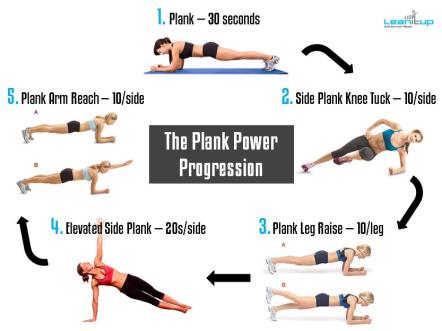
Core Strength
How’s your core? Have you been neglecting the most important part of your musculature? Abdominal muscles are the center region of your body for a reason. They are the alpha of all movement and support your frame during running and many workouts. Abdominal muscles are known as the powerhouse because it controls other muscle groups in the hip, back, upper and lower body. The four abdominal groups work as a whole and consist of:
- External oblique
- Internal oblique
- Rectus abdominal, and
- Traversus addominus
These four muscles act to stabilize a runner’s posture during running, control lower extremity motion, enhance performance (stride length, speed, and power) and prevent running-related injuries. Weak abdominal muscles can negatively affect lower extremity biomechanics by causing several running-related injuries such as bursitis, lower back pain, stress fractures, tendinitis and more. The abdominals aid other muscle groups to coordinate movement efficiently. Especially on grueling long runs, abdominal muscles hold you upright, helping you maintain proper posture on flat, hilly, and trail runs. Essentially, a strong core helps you become a more efficient runner.
Unfortunately, many runners neglect strength training, concentrating mainly on running and strengthening the lower extremities. This can causes instability, and imbalance in the musculature, thus leading to injuries.
So why aren’t you strengthening your core? It only takes 15 minutes three or four times a week, even less if your session is rigorous.
So Which Abdominal Exercises?
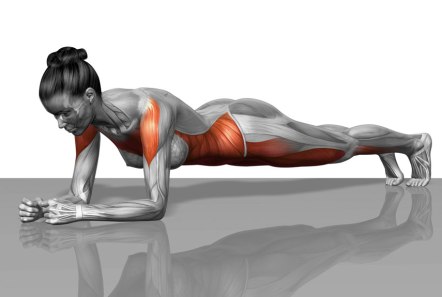
There are many ways to strengthen your core, through basic crunches or Pilates and yoga. Personally, I prefer Pilates and yoga because the poses are more efficient and don’t require hundreds of reps to feel the effect. Also, crunches only isolated one muscle, whereas Pilates and yoga exercises, such as the Plank, focus on training the core as an integrated stabilizing system. Planks work several muscle groups at once, such as the arms, abs, back, chest, shoulders, quads, and hamstrings. Several variations of the plank also effectively strengthen the arms and wrists along with the spine and abdomen. Planks target all core muscles, whereas basic crunches only target one muscle at a time, with the need to perform several specific exercises to hit all four core muscles (external and internal oblique, rectus abdominal, and traverse addominus).
Several Basic Versions of the Plank Pose
Dolphin Plank
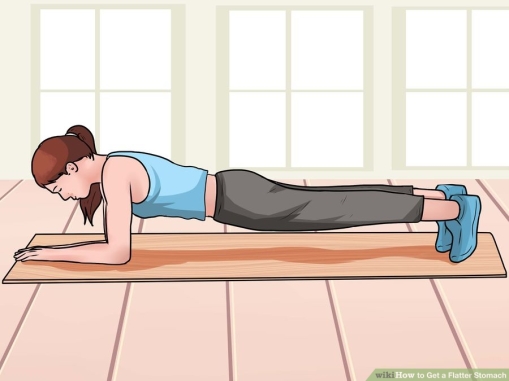
- Begin in pushup position.
- Place elbows under your shoulders with your upper arms vertical. Spread your fingers wide apart with even spacing between each finger and firmly press your palms onto the floor.
- Maintain a straight line from shoulders, legs, and pelvis.
- Slide your shoulder blades down the back, away from the spine, to stretch and elongated neck muscles. Shoulders should move away from the ears. Maintain the natural curve of your neck. Look straight down at the floor.
- Gently draw your front ribs and lower belly back toward your spine. Dig your toe pads into the floor as you reach from your pelvis and thighs through your heels. Do not raise or dip your buttocks. Keep the whole body in a straight line. Press down through the elbows to prevent humping the upper back.
- Try to hold the pose for as long as possible (15-30 seconds for beginners). Breathe.
- Exhale and then bring your knees down to rest. Repeat several times. Each time you perform this exercise, try to increase the number of seconds held.
One-leg-lifted Plank
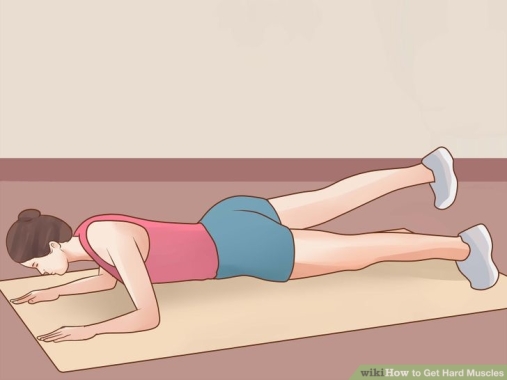
- Assume the plank pose above.
- Inhale and lift the left leg up and parallel to the floor.
- Keep the body lengthened and the tailbone pressed towards the pubis.
- Exhale on a count of 5 and lower foot back to the floor.
- Repeat on right leg.
- Repeat exercise several times alternating legs.
Straight- Arm Plank
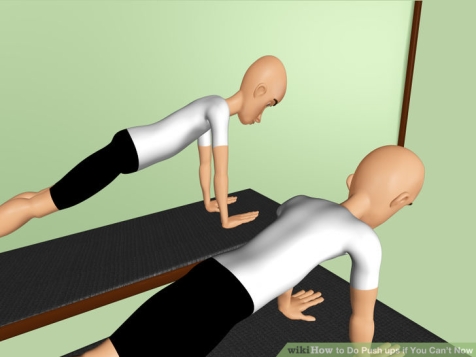
- Begin in pushup position.
- Keep arms straight.
- Extend legs behind you.
- Try to hold the position as long as possible (15-30 seconds for beginners).
- Lower knees to the floor and rest for three seconds.
- Repeat several more times.
Side Plank
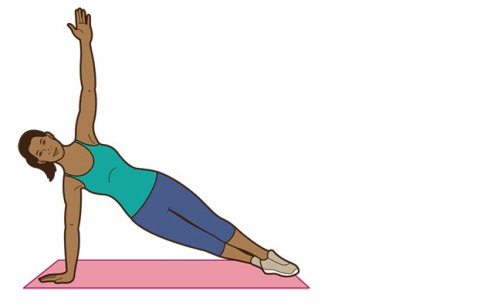
- Lying on your back, turn on your left side.
- Place your weight on your left foot.
- Stack your right foot onto your left foot.
- Press off the mat with your left arm, extending your right arm upward.
- Brace and hold for one minute or (15-30 seconds for beginners).
- Repeat on the other side.
Core Stretches
When you’re done strengthening your core, finish your workout with stretches to elongate the abdominal walls. The Cobra and bridge pose works well.
Cobra Pose (The Sanskrit name is Bhujangasana)
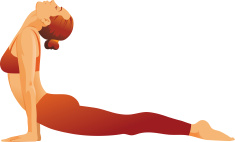
The Cobra Pose strengthens the spine and buttocks as well as stretches the chest, shoulders, and abdomen. Strength and flexibility are important components core training. Using the Cobra Pose, with a combination of other yoga poses, develops good body posture and improves abdominal and back strength.
- Lie face down on a mat, body extended along the floor.
- Place your palms on the floor behind your shoulders.
- Lengthen your legs and tailbone back.
- Gently and slowly lift your navel off the matt.
- Lift your chest forward and up, straightening your arms as much as you can without straining your back.
- Hold for 30 seconds, repeat again..
Bridge Pose (Setu Bandha Sarvangasana)

The Bridge Pose strengthens abdominal and back muscles, opens chest and hip flexors, and improves hip and spine flexibility.
- Lay supine on your back, bend knees with feet hip-width, parallel, and flat on the floor, place arms to the side of your body and for stability, keep palms on the floor.
- Exhale and slowly lift hips toward the ceiling, keeping the knees and thighs parallel.
- Engage the muscles of your lower back, buttocks, thighs and abdomen to keep the body firm.
- Lift the hips until the body is flat from chest to knees.
- To avoid placing stress on the neck, maintain a loose neck by lifting the chin away from the chest.
- Hold the pose for 30 seconds to one minute.
- Release with an exhale, and with one vertebra at a time, slowly roll the spine to the floor.
- Rest back into Child’s pose.
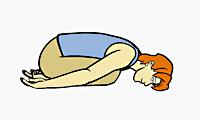



I love this exercises so much, I’m definitely going to bookmark this page so that I can develop the habit of doing this everyday. Thank you so much for posting this.
LikeLiked by 1 person
Thank You. Even ten to 15 minutes a day and you will see results. There are other variations once you get bored of this routine. I’ve be happy to throw them your way!
LikeLiked by 1 person
I will be so glad. Thank you so much.
LikeLiked by 1 person
Great post 👍 will definitely give this a go
LikeLike
Thanks! Just make it a part of your workout routine and you’ll see the results. By the way, I loved your post on Bibic.
LikeLiked by 1 person